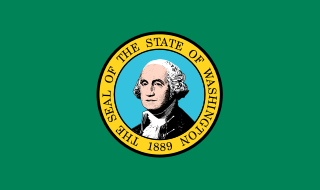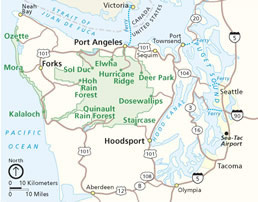Point Hannon, also known as Whiskey Spit, is a 7.7-acre (31,000 m2) sand spit with 1,775 feet (541 m) of no-bank shoreline, jutting out from the eastern edge of Hood Head, in the Hood Canal of the state of Washington. For surface navigation, Point Hannon is marked by a light. The low sandy spit with shoal water extends about 600 feet (180 m) east of the light. The open waters to the North of the spit, are among the deepest in Puget Sound. Local magnetic disturbances of more than 2° from normal variation have been observed in Hood Canal at Point Hannon.

A spit or sandspit is a deposition bar or beach landform off coasts or lake shores. It develops in places where re-entrance occurs, such as at a cove's headlands, by the process of longshore drift by longshore currents. The drift occurs due to waves meeting the beach at an oblique angle, moving sediment down the beach in a zigzag pattern. This is complemented by longshore currents, which further transport sediment through the water alongside the beach. These currents are caused by the same waves that cause the drift.

Hood Canal is a fjord forming the western lobe, and one of the four main basins, of Puget Sound in the state of Washington. It is one of the minor bodies of water that constitute the Salish Sea. Hood Canal is not a canal in the sense of being a man-made waterway—it is a natural waterway.

Washington, officially the State of Washington, is a state in the Pacific Northwest region of the United States. Named for George Washington, the first president of the United States, the state was made out of the western part of the Washington Territory, which was ceded by Britain in 1846 in accordance with the Oregon Treaty in the settlement of the Oregon boundary dispute. It was admitted to the Union as the 42nd state in 1889. Olympia is the state capital; the state's largest city is Seattle. Washington is sometimes referred to as Washington State to distinguish it from Washington, D.C., the capital of the United States.
Whiskey Spit has been a meeting point for native peoples, mariners, fishers, and loggers for hundreds of years. Port Gamble S'Klallum and Lower Elwha S'Klallum members tell of Tribal Gatherings, ceremonies, and ancestral canoe burials, as well as regular trapping, hunting, and fishing endeavors going back far beyond the first documented visits made by European explorers to Point Hannon in the 1790s, and continuing to the present day. Shanghaied crew aboard inbound clippers, loggers, and other freighters were waylaid at Whiskey Spit so that they would not escape, and they were replaced by Native crews for the remainder of the sail into Puget Sound and back. At peaks in logging and wartime military activity, Whiskey Spit has functioned as billet, brothel, speakeasy, and casino. Artifacts and relics should not be removed from the site.

Puget Sound is a sound along the northwestern coast of the U.S. state of Washington, an inlet of the Pacific Ocean, and part of the Salish Sea. It is a complex estuarine system of interconnected marine waterways and basins, with one major and two minor connections to the open Pacific Ocean via the Strait of Juan de Fuca—Admiralty Inlet being the major connection and Deception Pass and Swinomish Channel being the minor.
Whiskey Spit offers panoramic views of the Cascade Mountains, stretching from Mount Baker to Mount Rainier. With its sand dollar colony, moon snails, food sources for threatened salmon, and sea lion, harbor seal, gray whale, orca whale, harbor porpoise, bottlenose dolphin, muskrat, and river otter visitors, the spit is one of Washington's most special protected shorelines. The delicate freshwater marsh on the point provides the unique habitat requirements for the unusually wide range of nesting shore birds, migrating waterfowl, reptiles and amphibians, prey for the osprey, eagle, heron, and raven populations, and the essential foods for the plentiful sand lance and surf smelt.

Mount Baker, also known as Koma Kulshan or simply Kulshan, is a 10,781 ft (3,286 m) active glaciated andesitic stratovolcano in the Cascade Volcanic Arc and the North Cascades of Washington in the United States. Mount Baker has the second-most thermally active crater in the Cascade Range after Mount Saint Helens. About 31 miles (50 km) due east of the city of Bellingham, Whatcom County, Mount Baker is the youngest volcano in the Mount Baker volcanic field. While volcanism has persisted here for some 1.5 million years, the current glaciated cone is likely no more than 140,000 years old, and possibly no older than 80–90,000 years. Older volcanic edifices have mostly eroded away due to glaciation.

Mount Rainier, also known as Tahoma or Tacoma, is a large active stratovolcano located 59 miles (95 km) south-southeast of Seattle, in the Mount Rainier National Park. With a summit elevation of 14,411 ft (4,392 m), it is the highest mountain in the U.S. state of Washington, and of the Cascade Range of the Pacific Northwest, it is the most topographically prominent mountain in the continental United States and the first in the Cascade Volcanic Arc.

The term sand dollar refers to species of extremely flattened, burrowing sea urchins belonging to the order Clypeasteroida. Some species within the order, not quite as flat, are known as sea biscuits.
In May 2002, The Trust for Public Land conveyed the property to the Washington State Park System for permanent protection. A water access primitive campground was planned for state park land on Point Hannon, but the Friends of Point Hannon, North Olympic Salmon Coalition, Coastal Observation and Seabird Survey Team, Admiralty Audubon, Washington State Audubon Society, supporters of the Olympic Coast National Marine Sanctuary, and Northwest Water Resources oppose the conditional use permit and oppose exemption under the Jefferson County Shoreline Master Program.
The Trust for Public Land is a U.S. nonprofit organization with a mission to "create parks and protect land for people, ensuring healthy, livable communities for generations to come." Since its founding in 1972, The Trust for Public Land has completed 5,000 park-creation and land conservation projects across the United States, protected over 3 million acres, and helped pass more than 500 ballot measures--creating $70 billion in voter-approved public funding for parks and open spaces. The Trust for Public Land also researches and publishes authoritative data about parks, open space, conservation finance, and urban climate change adaptation. Headquartered in San Francisco, the organization is among the largest U.S. conservation nonprofits, with approximately 30 field offices across the U.S., including a federal affairs function in Washington, D.C.

The Washington State Park System is a set of state parks owned by the state government of Washington, USA. They are managed by the Washington State Parks and Recreation Commission. As of 2012, the parks are primarily funded through usage fees. There are over 100 parks throughout the state, including 19 marine parks and 11 Historical Parks.

The Olympic Coast National Marine Sanctuary is one of 14 marine sanctuaries administered by the National Oceanic and Atmospheric Administration (NOAA), an agency of the U.S. Department of Commerce. It is located along the Olympic Peninsula of Washington state. The sanctuary was declared in 1994 and encompasses 3,189 square miles (8,260 km2) of the Pacific Ocean from Cape Flattery in the north, to the mouth of the Copalis River, a distance of about 162.5 miles (261.5 km). Extending 25 to 40 miles from the shore, it includes most of the continental shelf, as well as parts of three important submarine canyons, the Nitinat Canyon, the Quinault Canyon and the Juan de Fuca Canyon. For 64 miles (103 km) along the coast, the sanctuary shares stewardship with the Olympic National Park. The sanctuary overlays the Flattery Rocks, Quillayute Needles, and Copalis Rock National Wildlife Refuges.














